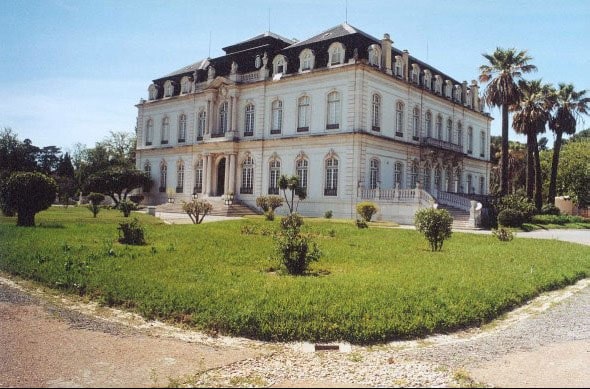Ever since I first saw the Palácio do Alto perched against the hilltop outside Faro, some 16 years ago, I had wanted to know more about it and, if possible, to visit. The opportunity arose a week ago, when our friend Rui, who teaches at the Colégio de Nossa Senhora do Alto, offered to conduct Lynne and me on a short and informal tour.
I knew that the Palácio had originally been built by, and belonged to, João António Júdice Fialho, a major businessman from Portimão. But why had he built such an impressive house, and as he was from Portimão, why did he build in Faro?
João António Júdice Fialho (1859–1934)
Júdice Fialho was an immensely successful businessman who seemed to make a success of every opportunity he encountered, with the one exception perhaps of his cod fishing fleet. He began his entrepreneurial life in partnership with his father in both winemaking and in importing. Their import business supported the important fishing industry and dealt in commodities such as fuel, steel cables and tar.
He soon branched out with a partner (Ferreira Neto) to build a distillery near Faro in 1881. They bought in figs and carobs and marketed spirits under the brand name of São Cristóvão.
They went into partnership with Francisco Pereira Matos in 1883, and their ‘aguardentes’ were marketed by their new company, Companhia Portuguesa de Álcoois e Açucares, located in the parish of Sé in Faro, and their products found favour in Lisbon. This factory came to consume daily 15,000 kilos of fruit and was a major employer. It also provided cattle feed from the waste products of the process of distillation.
Canning and shipbuilding
By the 1890s, Fialho was concentrating on the expanding canning business. He built factories in Portimão (1892 and 1904); Ferragudo (1904); Lagos (1904); Funchal (1909); Olhão (1913); Peniche (1915); Sines (1926) and Matosinhos.
His factories employed thousands of workers. In common with other canners in the region, Fialho’s factories also operated their own lithographic presses for printing on the tins. The most skilled and highest-paid workers were the solderers, who sealed the cans.
When the fishing boats unloaded, and the siren sounded to summon the workers, “saiem os operários em grandes agrupamentos fazendo cauda extensa ao longo das estradas” (the workers came out in large groups, snaking their way down the streets).
In 1896, Fialho took the major step of building and operating his own fishing fleet. He opened a shipyard in Portimão to build and repair his vessels, designated for the sardine and tuna fisheries. The effective means for sardine fishing was by use of the ‘cerco’ (surrounding a shoal with a deep net), and Fialho pioneered the use of a steamboat for this operation. His boats serviced the 10 tuna ‘armações’ which he managed at Bias, Torre de Barra, Torre Alta, Pedras Negras, Salema, Atalaia, Novas Ferrarias, Josefina, Calados and Zavial.
As well as shipping devoted to the support of fishing, Fialho also built and operated a cargo steamer operation both along the Algarve coast, and as far as Lisbon.
The transatlantic adventure
His biggest ship, a steamer with three masts, was launched in April 1918. He intended this ship to export his products to the Americas, and to import from there the various equipment and machinery for his manufacturing processes.
The one area where Fialho may be said to have been less successful was in the fishing of cod on the Grand Banks off Newfoundland. He erected in the Algarve the necessary buildings for the preparation and drying of fish. His five sailing ships were all known by the name ‘Algarve’. ‘Algarve I’ was wrecked on her first voyage in 1923 and ‘Algarve III’ ran aground on the bar at Portimão, also in 1923. Even so, in June 1925, he sent the three remaining ships to the Grand Banks.
Agriculture
With the profits from his businesses, Fialho bought a great area of farmland. His extensive agricultural holdings spanned the council areas of Olhão, Loulé, Faro, Olhão, Albufeira, Lagoa, and Portimão. One of his aims was to become self-sufficient in foods for his canning businesses, and his farmland yielded the necessary olive oil, tomato, peppers, garlic and various herbs.
The timber that he needed for shipbuilding came from his extensive holdings on the Serra de Monchique. He was always interested in further mechanisation to improve productivity and was a pioneer in the use of mechanical pumps for the extraction of water for agricultural use.
He was normally admired, but, in 1924, the weekly O Algarve criticised him for establishing rice fields in the Rio Seco area of Faro, since they became a “vast focus for diseases”.
Management style
Fialho’s management style was that of a paternalist. He knew all of his managers by their first name; he built accommodation for his workers. Even in 1908, when they were on strike against further mechanisation and he summoned the military to keep order, at Christmas he even-handedly distributed money to both strikers and soldiers. His factories were among the first in Portugal to have crèches and rooms where mothers could breastfeed their babies.
His business reputation is of intelligence and perspicacity, and, at the time, he was one of the richest men in Portugal. His businesses were arranged vertically – which means that he controlled the manufacturing process from the acquisition of the raw material to the sale of the finished product. In this way, he protected himself from the oscillations of the market.
Patriot and benefactor
He was also patriotic. During the Great War, he offered to the Red Cross thousands of cans of fish for the Portuguese troops serving on the Flanders front; he offered one of his ships (the ‘Galgo’ – the Greyhound) to patrol the Algarve coast; and contributed cables, netting and personnel for the sea defences of Lisbon in the River Tagus.
He accumulated an enormous quantity of capital from his export of tinned fish to the allied armies during WW1. But he was also a public benefactor and gave towards the Casa Santa Isabel in Faro, specifically to care for children orphaned by the Spanish flu epidemic in 1918; and to the ‘Cozinha Económica’ in Faro during the depression of 1929.
By Peter Booker
|| features@portugalresident.com
Peter Booker co-founded with his wife Lynne the Algarve History Association.
www.algarvehistoryassociation.com




















